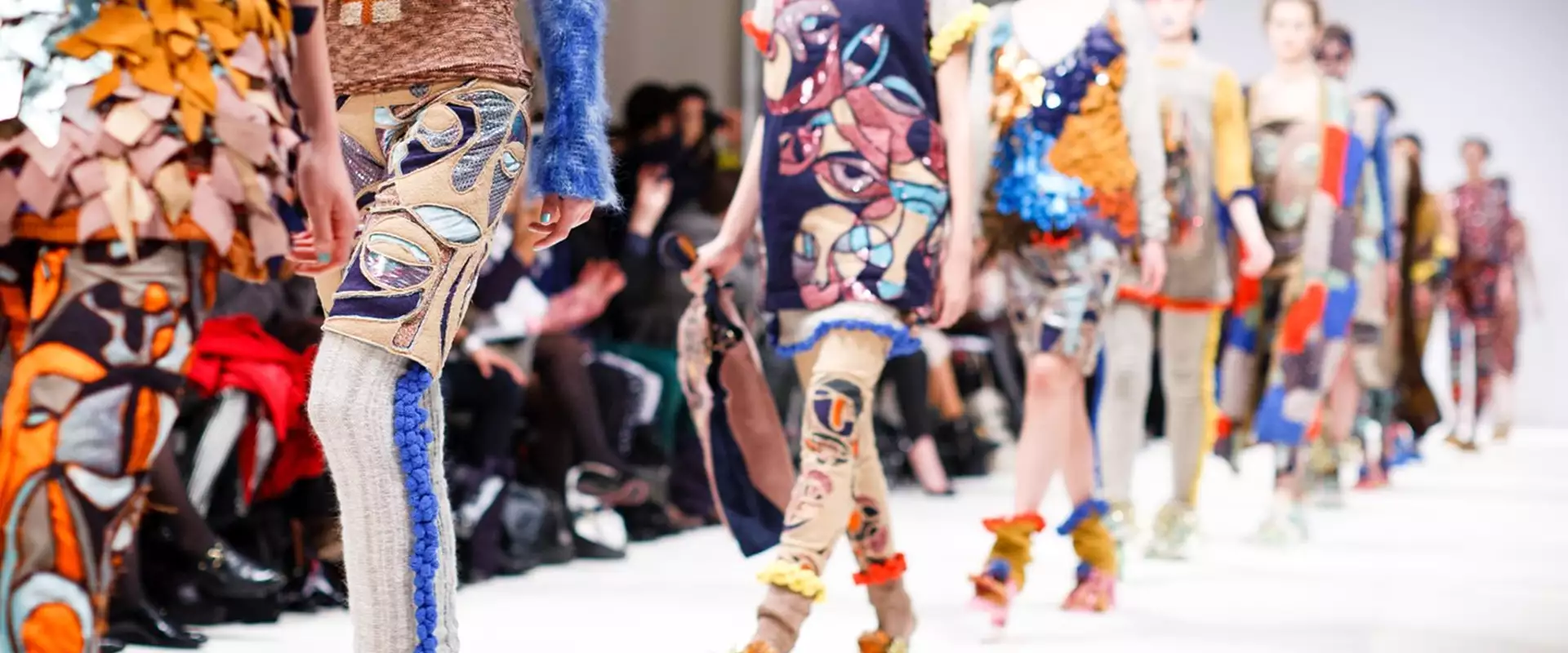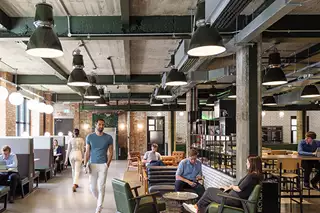
A Fashion Revolution: Fixing fashion's dirty secret
The fashion industry is the second biggest polluter after oil. Meet the pioneers weaving sustainability into the world of fashion
The glitz and glamour of Fashion Week is over for another year, but behind the empty catwalks and silent frowns is a burning question that won't go away: how can the fashion industry clean up its act? Workspace asked the difficult questions at an expert panel discussion at its latest Workspace Business Insight event, A Fashion Revolution: The Future of the Industry and your wardrobe, held at China Works in Vauxhall.
Discover smart clothing and circular fashion from Brooke Roberts-Islam, fashion tech and sustainability expert, Joanna Dai, Founder of DAI, Workspace customer based at E1 Studios, Dr. Kate Goldsworthy, co-director of the Centre for Circular Design at the University of the Arts London and Laura Balmond, project manager in the Make Fashion Circular team at the Ellen MacArthur Foundation.
What's the problem and how can we fix it?
The fashion industry's take-make-dispose model is wreaking devastation on the environment, not to mention the economy. The headline figures are alarming. According to Make Fashion Circular, every second, the equivalent of one garbage truck of textiles is landfilled or burned. Every year, around half a trillion dollars in value is lost from clothing being barely worn and rarely recycled.
If nothing changes, by 2050 the fashion industry will use up a quarter of the world’s carbon budget.
The problem is not just confined to fast fashion; it is endemic across all labels great and small. The news that Burberry burned £28 million of stock last year came as no surprise to fashion insiders - they are not the only one. As an industry worth $2.4 trillion, according to the McKinsey Global Fashion Index, it is under pressure to reform outdated practices like mass overproduction and clean up its bloated supply chains.
"We have a mission to accelerate transition towards the circular economy," says Laura. Circularity has its roots in ancient philosophy, but the concept has never been more pertinent in today's throwaway world. In a circular economy, economic activity builds and rebuilds overall system health. The Make Fashion Circular Initiative's three aims are to: design out waste and pollution; keep products and materials in use and regenerate natural systems.
Laura says, "Make Fashion Circular set out a vision for the fashion industry and this is based around three things. One is around developing new business models that keep clothing in use, the second one is around actually increasing demand for safe and renewable materials and the third one is around joining forces as an industry to ensure that used clothes can be turned into new ones."
The message is spreading. Global fashion brand H&M has pledged to become 100% circular and renewable by 2030, meaning it will use only recycled or other sustainably sourced materials in all its products. New designers are also putting sustainability front and centre, like Joanna Dai, founder of female performance wear brand, DAI. Her vision was to create breathable, machine washable clothes for high-flying women that "are not creased when you get off the plane".
She says "But once I started the brand and looked into the process of getting my product to market, it hit me in the face how unsustainable fashion is as an industry."
Joanna has incorporated sustainability in her business from the get-go through a number of means, including working with environmentally conscious mills and factories, adopting a customer recycling programme and encouraging customers to clean their garments only when needed.
Washing clothes releases half a million tonnes of plastic microfibres into the ocean every year, equivalent to more than 50 billion plastic bottles.
Recycling and innovation
Fashion designers are getting creative in finding new ways to make their clothing lines more sustainable. Adidas works with environmental organisation Parley for the Oceans to create trainers made from fishing nets and plastic waste.
Plastic waste and other synthetic materials have a bad rep, but some argue that it is better to re-use these than dispose of them in landfill. "Synthetics can be sustainable. At London Fashion Week there were several brands using recycled fishing net yarns to make swimwear," explains Brooke.
Kate agrees. "Sometimes whole material groups can be blamed for certain things. But we can't live our lives without plastic; it's a by-product of the oil industry. Synthetics can do some things that fibres can't, like in the medical field. We've made enough polyester since the 1950s for an ongoing supply; we can harness that."
How often have you bought an item, worn it a few times and left it to languish in your wardrobe? Check out these apps recommended by our experts to cut waste and help recycle.
Zozosuit: Say goodbye to standard sizes and hello to custom-fit clothes. This free app lets you take 3D measurements of your body and order clothing that is made to fit your exact body shape at Uniqlo prices.
Depop: Sick of your old clothes? Don't chuck them away, snap a few pics and whack them on buying and selling phone app Depop. A great way to find a new home for your clothes and make a bit of pocket money.
Nevertheless, renewable materials are the future for the fashion industry. Science plays a significant role in bringing sustainability to the textile industry, with exciting new players like AlgiKnit and Orange Fiber. AlgiKnit is developing a "Bioyarn" made from natural ingredients like seaweed and algae, while Orange Fiber creates fabrics from discarded orange peel by extracting a silk-like cellulose yarn. Italian fashion house Salvatore Ferragamo is the first to use Orange Fiber fabrics in its collection.
Still, the fashion industry faces hurdles. Chemical recycling can be tricky with certain fibres, for example when elastane is blended with a material like cotton, says Brooke. Customer apathy is a huge problem as well, says Joanna, citing a low-uptake of her company's recycling programme. The fashion industry needs to come together to find a solution.
Kate says, "Collaboration is really important across brands. You've got to have a unified message to tell brands what to do. Lots of research says consumers are willing to pay more and demand recycled materials, but I think quite often they want to go a brand they trust will do hard work for them."
Watch Brooke Roberts-Islam explain how fashion brands can be both profitable and sustainable:
Tech meets textiles
Mass customisation is touted as the answer to the fashion industry's fix to its pollution problem. For Hal Watts, CEO at fashion technology business, Unmade, automated printing and knitting is powering the success of his made-to-order clothing business. The Japanese first pioneered computerized knitting machines - Shima Seiki was founded on the challenge of developing the world's first automated glove knitting machine. UK-based software company Unmade was founded in 2014 to help shift the fashion industry from mass production to an on-demand supply chain model. Shoppers can customise items using smart online tools to create an order that is sent directly to the factory. Investors are sitting up and taking notice. Unmade secured $4m in funding in August from the likes of Felix Capital, Connect Ventures, Net-a-Porter founding investor Carmen Busquets and more. It pays to be sustainable.
Hal says, "What gets me out of bed in the morning is trying to improve the industry and take an industry that is very polluting to be something that’s really positive."
Unmade - automated printing and knitting:
Further reading
Read more about the sustainable future of fashion in the latest issue of homeWORK magazine in Lifting the Veil on page 22.
Find out more about Joanna Dai in our interview in My Workspace on page 66.
Discover the pioneering work of the Brooke Roberts Innovation Agency (BRIA) at brinnovationagency.com
Learn more about Make Fashion Circular at tiny.cc/mnblzy
Do you need more flexibility? Our co-working options are available across London.
Get in touch today to book a tour and we’ll help you find the perfect office space for your business.

